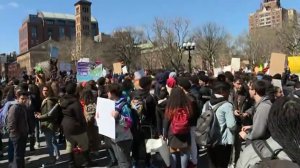For the second time in two months, thousands of students from across the country are streaming out of class Friday as part of a National School Walkout to demand action on gun reform — even as Florida police investigate a fresh shooting that injured a high school student Friday morning.

Students are walking out of class at 10 a.m. in each time zone to observe a moment of silence for shooting victims.
Before Friday’s walkouts began, the latest school shooting happened in Ocala, Florida, some 65 miles northwest of Orlando. Police said a student was shot in the ankle at Ocala’s Forest High School, and a suspect is in custody.
Friday’s walkouts, while drawing momentum from February’s mass shooting at South Florida’s Marjory Stoneman Douglas High School, also marks the 1999 Columbine High School massacre in Colorado in which two gunmen killed 12 students and a teacher.
Many students across the country — including current Columbine students — say not enough has been done to help prevent mass shootings.
Besides observing moments of silence, other actions during the day will include marching to a local lawmaker’s office, allowing open-mic time for students to share concerns and helping register those who are eligible to vote. Students at more than 2,500 schools were set to participate.
Teachers, too, are marking the day. At Marjory Stoneman Douglas High, where a gunman massacred 17 people two months ago in Parkland, Florida, teachers got an early start, demonstrating outside the building before classes began.
Those teachers combined calls against gun violence with requests for more school funding.
“Enough is enough!” they chanted, holding signs with messages such as “Children’s lives > assault rifles,” “Arm me with school funding” and “Arm me with better pay and lower class size.”
Lane Murdock, 16, a sophomore from Ridgefield, Connecticut, launched the National School Walkout.
She was disturbed by her own reaction — or lack thereof — to the February massacre in Florida.
“When I found out about the shooting at MSD, I remember I didn’t have a huge reaction. And because of that, I knew I needed to change myself, and we needed to change this country,” Lane said.
“We should be horrified, and we’re not anymore. It’s American culture.”
Lane said students should be empowered “to do the walkouts and become leaders in their communities, speaking up when they see inaction.”
Push for legislation
The movement also encourages young people to push for legislation at the state level if Congress doesn’t act.
“The federal government can set standards and practices that apply to all states around gun safety. But states have the option of passing additional measures to protect their own residents from gun violence,” its website says.
Students are calling for several measures, including banning assault weapons, high-capacity magazines and bump stocks; mandating universal background checks; placing a minimum age of 21 on all gun purchases; implementing waiting periods between a gun purchase and gun transfers; and allowing families to petition a court to remove guns from individuals at risk of injuring themselves.
While there hasn’t been major congressional action since the Parkland massacre, some cities and states have toughened gun control.
In Florida, after Parkland students rallied at the state Capitol, Republican Gov. Rick Scott signed a gun bill called the Marjory Stoneman Douglas High School Public Safety Act. It raises the minimum age to buy any firearm in the state to 21, bans the sale or possession of bump fire stocks and adds $69 million in funding for mental health services in schools.
In Vermont, Republican Gov. Phil Scott banned bump stocks, limited the size of magazines, expanded background checks for gun purchases and raised the minimum age to purchase firearms to 21.





















